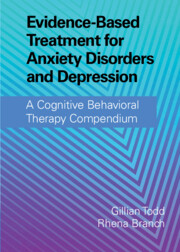 Evidence-Based Treatment for Anxiety Disorders and Depression
Evidence-Based Treatment for Anxiety Disorders and Depression Published online by Cambridge University Press: 06 January 2022
The efficacy of disorder-specific cognitive behavioral therapy (CBT) treatment protocols for anxiety and depression is well established. This state-of-the-art compendium brings together, in one volume, a therapist guide to treating anxiety disorders, posttraumatic stress disorder, obsessive compulsive disorder (including six subtypes), and depression. Treatment protocols are based on the DSM-5 taxonomy diagnoses that address the nuances of specific clinical presentations. There is section on case formulation and treatment planning to assist therapists when working with clients presenting with complexity and comorbid disorders. Specific CBT approaches and treatment protocols for diverse populations with common mental health problems are also provided. Experts in their field from around the world have shared their protocols and wisdom to enable the reader (1) to develop their knowledge base of current research, (2) to understand the phenomenology of psychological disorders, (3) to learn idiosyncratic additions to the assessment process, (4) to follow a step-by-step guide to treatment, (5) to identify and overcome common problems in treatment, and (6) to effectively evaluate treatment progress. The compendium is written in an accessible style that lends the reader a sense of having an expert clinical supervisor educating and guiding, helping to build knowledge and skill.
To save this book to your Kindle, first ensure no-reply@cambridge.org is added to your Approved Personal Document E-mail List under your Personal Document Settings on the Manage Your Content and Devices page of your Amazon account. Then enter the ‘name’ part of your Kindle email address below. Find out more about saving to your Kindle.
Note you can select to save to either the @free.kindle.com or @kindle.com variations. ‘@free.kindle.com’ emails are free but can only be saved to your device when it is connected to wi-fi. ‘@kindle.com’ emails can be delivered even when you are not connected to wi-fi, but note that service fees apply.
Find out more about the Kindle Personal Document Service.
To save content items to your account, please confirm that you agree to abide by our usage policies. If this is the first time you use this feature, you will be asked to authorise Cambridge Core to connect with your account. Find out more about saving content to Dropbox.
To save content items to your account, please confirm that you agree to abide by our usage policies. If this is the first time you use this feature, you will be asked to authorise Cambridge Core to connect with your account. Find out more about saving content to Google Drive.